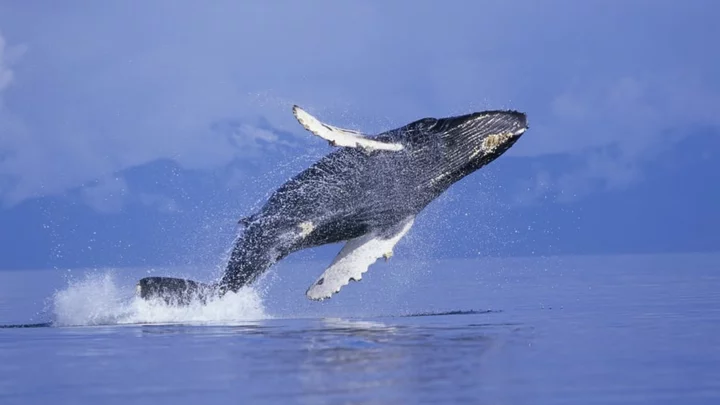Conservationists can’t afford to become complacent. When it comes to rescuing endangered species, progress is an ongoing effort. Still, we can take comfort in the knowledge that many organisms once on the brink of extinction or endangerment have made tremendous comebacks with our help. Just look at what happened to these 25 plants and animals.
1. The Bald Eagle
For much of the 20th century, this American icon was in jeopardy. Habitat loss, hunting, and the widespread use of DDT—an insecticide that weakens avian eggshells—once took a major toll on bald eagles. By 1963, the species population in the lower 48 states had fallen from an estimated 100,000 individuals to just 417 wild pairs. To turn things around, the U.S. government passed a series of laws, including a 1973 ban on DDT that was implemented by the Environmental Protection Agency (EPA). These efforts paid off; today, there are more than 71,400 nesting pairs in the lower 48.
2. The Arabian Oryx
The Arabian oryx is a desert antelope indigenous to the Middle East. Reckless hunting devastated the species, which became essentially extinct in the wild during the early 1970s. But a few were still alive and well in captivity, so, in the 1980s, American zoos joined forces with conservationists in Jordan to launch a massive breeding program. Thanks to their efforts, the oryx was successfully reintroduced to the Arabian Peninsula, where over 1000 wild specimens now roam (with a captive population of about 7000).
3. The Gray Wolf
Even well-known conservationists like Theodore Roosevelt used to vilify America’s wolves. Decades of bounty programs intended to cut their numbers down to size worked all too well; by 1965, only 300 gray wolves remained in the lower 48 states, and those survivors were all confined to remote portions of Michigan and Minnesota. Later, the Endangered Species Act enabled the canids to bounce back in a big way. Now, about 5500 of them roam the contiguous states.
4. The Brown Pelican
Louisiana’s state bird, the brown pelican, is another avian species that was brought down by DDT. In 1938, a census reported that there were 500 pairs living in Louisiana. But after farmers embraced DDT in the 1950s and 1960s, these once-common birds grew scarce. Things got so bad that, when a 1963 census was conducted, not a single brown pelican had been sighted anywhere in Louisiana. Fortunately, now that the era of DDT is over, the pelican is back with a vengeance on the Gulf Coast and no longer considered endangered.
5. Robbins’ Cinquefoil
Noted for its yellow flowers, Robbins’s cinquefoil (Potentilla robbinsiana) is an attractive, perennial plant that’s only found in New Hampshire’s White Mountains and Franconia Ridge. Collectors once harvested the cinquefoil in excessive numbers and careless backpackers trampled many more to death. In response, the U.S. Fish and Wildlife Service re-routed hiking trails away from the flower’s wild habitats. This, along with a breeding program, rescued the Robbins’ cinquefoil from the brink of extinction.
6. The American Alligator
With its population sitting at an all-time low, the American alligator was recognized as an endangered species in 1967. Working together, the Fish and Wildlife Service and governments of the southern states took a hard line against gator hunting while also keeping tabs on free-ranging alligator populations. In 1987, it was announced that the species had made a full recovery [PDF].
7. The Northern Elephant Seal
Due to its oil-rich blubber, the northern elephant seal became a prime target for commercial hunters. By 1892, some people were beginning to assume that it had gone extinct. However, in 1910, it was discovered that a small group—consisting of fewer than 100 seals—remained on Guadalupe Island. In 1922, Mexico turned the landmass into a government-protected biological preserve. From a place of security, that handful of pinnipeds bred like mad. Today, every single one of the 160,000 living northern elephant seals on Earth are that once-small group’s descendants.
8. The Humpback Whale
Did you know that the world’s humpback whale population is divided into 14 geographically defined segments? Well, it is—and in 2016, the National Ocean and Atmospheric Administration (NOAA) informed the press that nine of those clusters are doing so well that they no longer require protection under the U.S. Endangered Species Act. The cetaceans’ comeback is a huge win for the International Whaling Commission, which responded to dwindling whale numbers by enacting a commercial hunting moratorium.
9. The Fin Whale
Commercial whaling decimated global populations of fin whales, the second-largest species of baleen whale on Earth. In the 1970s, international coalitions banned commercial fin whale hunting in the Southern Hemisphere and the North Pacific, and legal catches were reduced in the North Atlantic in the 1990. Though three countries—Norway, Iceland, and Japan—continue to hunt whales for oil and meat, the IUCN reported in 2018 that the fin whale population has doubled since the 1970s.
10. The White Rhino
Make no mistake: The long-term survival of Earth’s largest living rhino is still very uncertain because poachers continue to slaughter them en masse. Nevertheless, there is some good news. Like black-footed ferrets and northern elephant seals, white rhinos were once presumed to be extinct. But in 1895, just under 100 of them were unexpectedly found in South Africa. Thanks to environmental regulations and breeding efforts, more than 20,000 are now at large.
11. The Wild Turkey
It’s hard to imagine that these birds were ever in any real trouble, and yet they looked destined for extinction in the early 20th century. With no hunting regulations to protect them, and frontiersmen decimating their natural habitat, wild turkeys disappeared from several states. By the 1930s, there were reportedly fewer than 30,000 left in the American wilderness. Now, over 6 million are strutting around. So what changed? A combination of bag limits set by various agencies and an increase in available shrublands.
12. The Black-Footed Ferret
North America’s only indigenous ferret is a prairie dog-eater that was written off as “extinct” in 1979. But the story of this animal took a surprising twist two years later, when a Wyoming dog gave a freshly dead one to its owner. Amazed by the canine’s find, naturalists soon located a wild colony. Some of these ferrets were then inducted into a breeding program, which helped bring the species’ total population up to over 1000.
13. The California Condor
Since 1987, the total number of California condors has gone up from 27 birds to about 560, with 347 of those being wild animals (according to 2022 data). With its 10-foot wingspan, this is the largest flying land bird in North America.
14. The Golden Lion Tamarin
A flashy orange primate from Brazil’s Atlantic Forest, the golden lion tamarin has been struggling to cope with habitat destruction. The species hit rock-bottom in the early 1970s, when fewer than 200 remained in the wild. A helping hand came from the combined efforts of Brazil’s government, the World Wildlife Federation, public charities, and 150 zoos around the world. There’s now a healthy population of captive tamarins tended to by zookeepers all over the globe. Meanwhile, breeding, relocation, and reintroduction campaigns have increased the number of wild specimens to around 2500—although urban sprawl could threaten the species with another setback. But at least the animal doesn’t have a PR problem: Golden lion tamarins are so well-liked that the image of one appears on a Brazilian banknote.
15. The Island Night Lizard
Native to three of California’s Channel Islands, this omnivorous, 4-inch reptile was granted federal protection under the Endangered Species Act in 1977. The designation couldn’t have come at a better time, as introduced goats and pigs were decimating the night lizard’s wild habitat in those days. But now that wild plants have been reestablished under FWS guidance, more than 21 million of the reptiles are believed to be living on the islands.
16. The Okarito Kiwi
Small, flightless, island birds usually don’t fare well when invasive predators arrive from overseas. (Just ask the dodo.) New Zealanders take great pride in the five kiwi species found exclusively in their country, including the Okarito kiwi, which is also known as the Okarito brown or rowi kiwi. These animals have historically suffered at the hands of introduced dogs and stoats. But recently, there’s been some cause for celebration. Although there were only about 150 Okarito kiwis left in the mid-1990s, conservation initiatives have triggered a minor population boom, with about 450 adult birds now wandering about. Taking note of this trend, the International Union for Conservation of Nature (IUCN) has declared that the Okarito kiwi is no longer endangered.
17. The Brown Bear
Let’s clear something up: The famous grizzly bear technically isn’t its own species. Instead, it’s a North American subspecies of the brown bear (Ursus arctos), which also lives in Eurasia. Still, grizzlies are worth mentioning here because of just how far they’ve come within the confines of Yellowstone National Park. In 1975, there were only 136 of them living inside the park. Today, approximately 1063 of them call the area home. In 2017, the FWS delisted the Greater Yellowstone population grizzlies from Endangered Species Act protection, but reinstated them in 2018 as “threatened“ to comply with a Montana court ruling.
18. The Thermal Water Lily
With pads that can be as tiny as a centimeter across, the thermal water lily is the world’s smallest water lily. Discovered in 1985, it was only known to grow in Mashyuza, Rwanda, where it grew in the damp mud surrounding the area’s hot spring. Or at least it did. The thermal water lily seems to have disappeared from its native range. Fortunately, before the species went extinct in the wild, some seeds and seedlings were sent to London’s Royal Botanic Gardens at Kew. There, horticulturalists figured out a way to make the lilies flower in captivity, and managed to saved the species.
19. The Peregrine Falcon
When a peregrine falcon dives toward its airborne prey, the bird-eating raptor has been known to hit speeds of up to 242 mph. The species endured a plummet of a different sort when DDT dropped its population. In the first few decades of the 20th century, there were around 3900 breeding pairs in the United States. By 1975, the number of known pairs had been whittled down to 324. Things got better after the insecticide was banned, and according to the American Bird Conservancy, there are now roughly 40,000 peregrine falcon inNorth America.
20. Przewalski’s Horse
There are a few different subspecies of wild horse, all of which are endangered. One variant is the Przewalski’s horse (Equus ferus perzewalskii) from Mongolia. It completely vanished from that nation during the 1950s, but by then assorted zoos around the world had started breeding them. From 1992 to 2004, some 90 captive-born horses were released into Mongolia, where they thrived. Other populations have been successfully introduced in Hungary and Russia (including in the Chernobyl exclusion zone); there are about 1400 of the horses alive today.
21. The North American Beaver
According to some estimates, there were hundreds of millions of these buck-toothed rodents living on North America before European fur traders showed up. But after two centuries of over-trapping, spurred by the lucrative pelt trade, the number of North American beavers had shrunk to an abysmal 100,000 in 1900. Their fortunes reversed when restocking programs were implemented in the U.S. and Canada. Nowadays, somewhere between 10 and 15 million beavers live in those countries. Thanks to beaver’s amazing landscaping talents, many property owners have come to see them (unfairly) as pests.
22. The Café Marron
Rodrigues Island in the Indian Ocean once gave biologists a chance to raise the (near) dead. This landmass is the home of a small tree with star-shaped flowers called the café marron. It was thought that the plant had long since died out when a single specimen was found by a schoolboy named Hedley Manan in 1980. As the only surviving member of its species known to humankind, that lone plant assumed paramount importance. Cuttings from the isolated café marron were used to grow new trees at England’s Royal Botanical Gardens at Kew. Right now, there are more than 50 of these plants—and all of them can have their ancestry traced straight back to that one holdout tree.
23. The West Indian Manatee
A docile, slow-moving marine mammal with a taste for sea grasses, the Floridian subspecies of the West Indian manatee is a creature that does not react well to razor-sharp propellers. Collisions with boats are a significant threat, and the danger won’t go away altogether. The passage of tighter boating regulations has helped the Sunshine State rejuvenate its manatee population, which has more than tripled since 1991. However, the species isn't out of the woods yet. Their numbers declined sharply in recent years from starvation caused by a drastic sea grass die-off, though the number of deaths has slowed this past year thanks to a feeding program and sea grass regrowth.
24. The Burmese Star Tortoise
The pet trade did a number on these guys. Beginning in the 1990s, wildlife traffickers harvested Burmese star tortoises until they effectively became “ecologically extinct” in their native Myanmar. Luckily, conservationists had the foresight to set up breeding colonies with specimens who’d been confiscated from smugglers. The program started out with fewer than 200 tortoises in 2004; today, it has more than 14,000 of them. “Our ultimate objective is to have about 100,000 star tortoises in the wild,” Steve Platt, a herpetologist who’s been taking part in the initiative, said in the Wildlife Conservation Society video above.
25. The Giant Panda
Here we have it: the poster child for endangered animals everywhere … except that the giant panda is no longer endangered. In 2016, the IUCN changed its status from “endangered” to “vulnerable.” There’s still a chance that we could lose the majestic bamboo-eater once and for all someday, but the last few years have offered a bit of hope. Between 2004 and 2014, the number of wild pandas increased 17 percent. The welcome development was made possible by enacting a poaching ban and establishing new panda reserves. It’s nice to know that, with the right environmental policies, we can make the future brighter for some of our fellow creatures.
A version of this story originally ran in 2017; it has been updated for 2023.
This article was originally published on www.mentalfloss.com as 25 Species That Have Made Amazing Comebacks.









